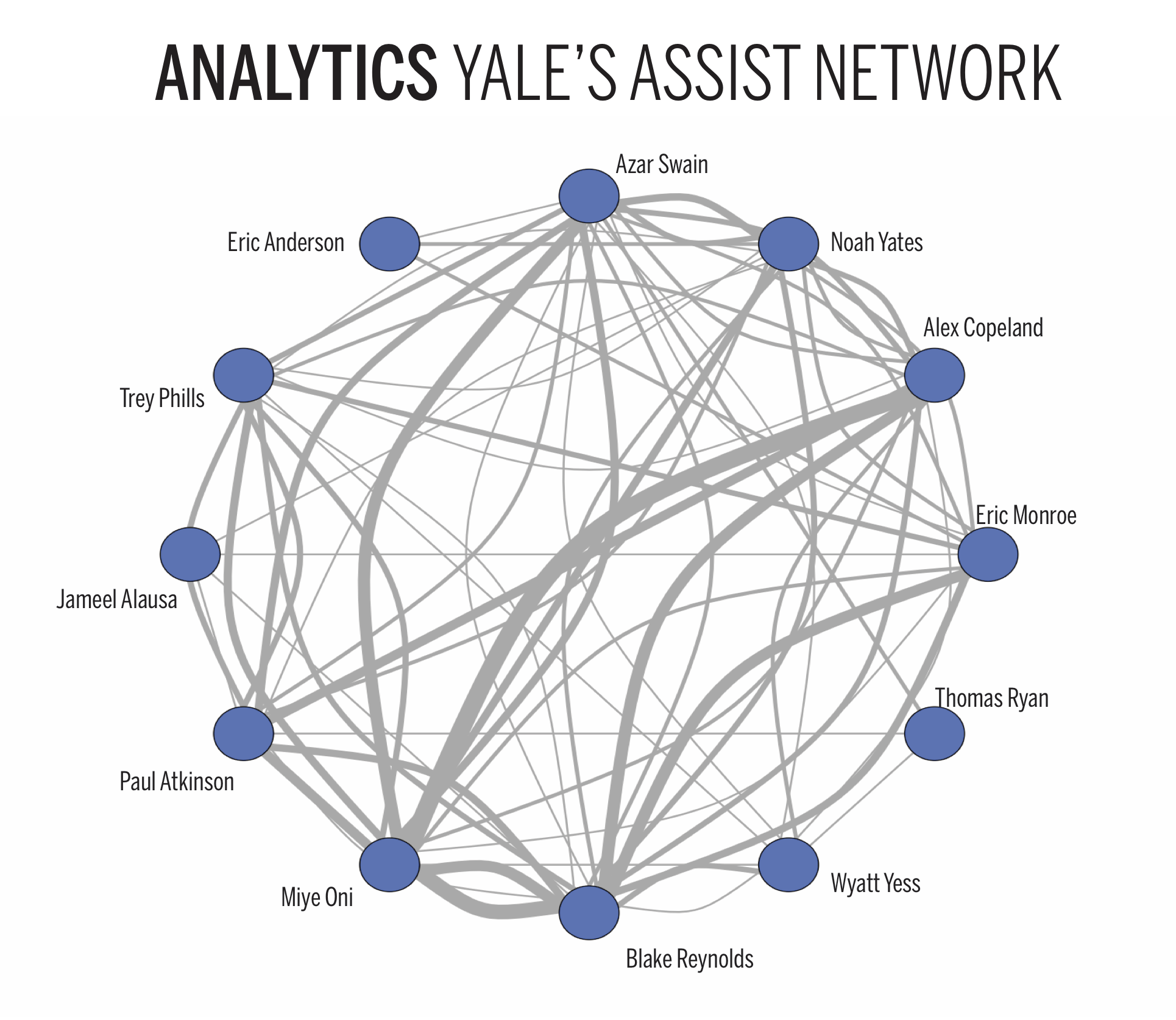
Entering the season, expectations for the Yale men’s basketball team, and the Ivy League as a whole, were through the roof. The Bulldogs’ lineup would be comprised of familiar faces, none bigger than star point guard Makai Mason ’18, who was set to return from the broken foot that caused him to miss the entire 2016–17 season. But unfortunately, just a week before the 2017–18 season opener against Creighton, Mason sustained a stress fracture in the same foot that kept him out last year. Whether the senior point guard will return this season remains to be seen. So while Bulldog fans wait, let’s examine how Yale has moved the ball in his absence.
Below is a graphic representing the Elis’ assist network through the first 10 games of the season. Each node represents a player, while edges connecting the nodes indicate an assist that was made between the players. Thicker edges indicate that more assists were made between the players in question. Put simply, this network shows the distribution of how Yale players make baskets immediately following a timely pass from their teammates.
A quick visual inspection of Yale’s assist network leads to some interesting observations. To begin, it’s readily clear that Miye Oni ’20 has been Yale’s most important player thus far. Not only is he a scoring machine, but he also has been instrumental in involving his teammates on the offensive end. This is a positive sign for the Bulldogs, as point guard was not Oni’s primary role last season, and he seemed to struggle in this fill-in role during the daunting road matchups against Creighton and Wisconsin. Perhaps some of the pressure that typically falls on the shoulders of the team’s primary ball-handler has been relieved by Alex Copeland ’19. Copeland functioned as the backup point guard last season for Anthony Dallier ’17, and his experience distributing the ball will surely help Yale while Mason remains sidelined.
In fact, the Copeland-to-Oni connection has been the most prolific for the Elis this season, with Oni on the receiving end of nine assists from Copeland, good for 5.3 percent of Yale’s assisted baskets this season. Converting 17.8 percent of the Bulldogs assisted baskets, Blake Reynolds ’19 has been one of the main beneficiaries of quality passes from his teammates. In Mason’s absence, five players have each contributed at least 10 percent of Yale’s assists: Copeland with 17.8, Oni with 16.0, Reynolds with 14.8, Azar Swain ’21 with 11.8 and Eric Monroe ’20 with 10.7.
This even distribution of assisted shots speaks both to the depth of Yale’s back court and the total team effort required to replace a star point guard like Mason. The Bulldog’s assist network stands in contrast to those of other Ivy teams. Yale is the only school in the Ancient Eight without a single player contributing more than 20 percent of his team’s assists. Princeton for example, is led by senior guard Amir Bell, who has accounted over one-third of the Tigers’ assists. Reigning Ivy League rookie of the year Bryce Aiken leads Harvard with 28.5 percent of the Crimson’s assists. Networks of these sort have a property called the clustering coefficient, a number between zero and one, with higher numbers being more evenly distributed clusters. Yale’s clustering coefficient of 0.722 ranks second in the conference, behind only Harvard, which has 0.756.
At 5–5, the Elis have been able to weather the storm without Mason, and they should only get stronger if Mason is able to return this season. With conference play just a few weeks away, Yale basketball fans can rest easy knowing their team is as deep and balanced as any in the Ivy League.
Luke Benz | luke.benz@yale.edu
Luke Benz is the president of the Yale Undergraduate Sports Analytics Group.







